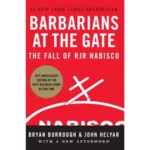LISTEN NOW
Outline: RJR Nabisco Leveraged Buyout (LBO) and Its Implications
Outline
Expand to Read ...
Introduction
- Subject: The 1988 RJR Nabisco leveraged buyout (LBO) for $25 billion.
- Significance: Largest business transaction of the 20th century; pivotal moment for LBOs.
- Themes:
- LBO mechanics and controversy.
- Profile of RJR Nabisco CEO Ross Johnson.
- Detailed chronology of the buyout.
- Aftermath and legacy of LBOs.
Part 1: The Basics of Leveraged Buyouts (LBOs)
What is an LBO?
- Definition: A company is taken private using mostly borrowed funds, with company assets as collateral.
- Process:
- Management team buys all company stock.
- Removes company from the stock market.
- Replaces the board with representatives of new owners.
- Key Players: Management team, financial consulting firm (often acquires a controlling share).
- Funding Mechanism: Junk bonds (high-risk, high-interest securities).
Motives for LBOs
- Executives can increase income through dividends.
- Tax advantages: Interest on loans is deductible, unlike stockholder dividends.
- Financial firms profit from fees and ownership dividends.
Part 2: Ross Johnson and RJR Nabisco
Johnson’s Philosophy
- Change is Vital: Frequent restructuring to prevent stagnation.
- Liberal Spending: High executive wages, lavish perks, and networking-focused expenditures.
Johnson’s History of Mergers
- Career Highlights:
- Rose from modest beginnings in Canada.
- CEO roles at Standard Brands and Nabisco.
- Orchestrated mergers leading to the creation of RJR Nabisco.
- Impact at RJR Nabisco:
- Moved headquarters to Atlanta, boosting sales and profits.
- Maintained strong relations with the board.
Why Johnson Initiated the LBO
- Motivations:
- Frustration with stagnant stock price.
- LBO as a solution to deliver shareholder value.
- Partnership with Shearson Lehman:
- Secured generous terms: veto power, high dividends.
- Shearson’s aim: gain market leadership in LBO consulting.
Part 3: The Bidding Contest for RJR Nabisco
Unusual Competitive Bidding
- Johnson proposed the LBO early to maintain board relations.
- Press release about $75/share bid attracted other financial firms.
Major Competitors
- Kravis (Kohlberg Kravis Roberts):
- Market leader in LBOs.
- Disadvantaged due to lack of inside knowledge.
- Bid $90/share, later raised to $106/share.
- Salomon Brothers:
- Partnered with Shearson Lehman, raising the bid to $92/share.
- Forstmann Little:
- Avoided junk bonds, withdrew after determining $85–$90/share was viable.
- First Boston:
- Late entry, proposed $105–$118/share but failed to secure funding.
Formal and Second-Round Bidding
- Final bids:
- Johnson’s team (Shearson-Salomon): $101/share.
- Kravis: $106/share, backed by insider information on expenses.
Part 4: The Third Round and Outcome
Final Bids
- Johnson’s team: $112/share (higher risk junk bonds).
- Kravis: $109/share (lower risk junk bonds).
- Board’s Decision:
- Considered bids equal due to risk-adjusted valuations.
- Chose Kravis due to:
- Advanced preparations with Kravis.
- Negative press about Johnson’s greed and lavish partnership terms.
Why Johnson Lost
- Early board proposal invited competition.
- Publicized partnership terms alienated the board and public opinion.
- Loss-aversion bias drove decisions that backfired.
Part 5: Aftermath
Impact on Key Players
- Ross Johnson:
- Retired gracefully in 1988.
- Maintained his stance that the LBO was best for shareholders.
- Kravis:
- Restructured RJR Nabisco, increased profits by 50%.
- Made a modest profit after selling the company.
Legacy of the RJR Nabisco LBO
- LBOs declined in popularity after the negative publicity.
- Junk bonds became controversial.
- Forstmann Little gained prominence as a junk bond-free LBO firm.
Part 6: Long-Term Trends and Lessons
LBO Trends Post-RJR Nabisco
- 1990s: Decline in LBO activity.
- 2000s: Resurgence until the 2008 financial downturn.
- 2020s: LBO volume surpasses previous peaks.
Key Takeaways
- Economic Impact: Highlighted risks of excessive corporate debt.
- Behavioral Insights: Loss-aversion bias shaped key decisions.
- Cultural Legacy: Barbarians at the Gate book and movie immortalized the drama.
Conclusion
- Significance: RJR Nabisco LBO was a watershed moment in corporate finance, reshaping perceptions of LBOs and influencing financial strategies for decades.
- Final Reflection: Johnson’s legacy is a blend of controversy and lasting fame, underscoring the complex ethics and economics of high-stakes business deals.

 Buy on Amazon
Buy on Amazon